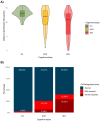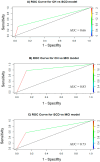Olfactory Identification as a Biomarker for Cognitive Impairment: Insights from Healthy Aging, Subjective Cognitive Decline, and Mild Cognitive Impairment
- PMID: 39727504
- PMCID: PMC11675861
- DOI: 10.3390/ejihpe14120196
Olfactory Identification as a Biomarker for Cognitive Impairment: Insights from Healthy Aging, Subjective Cognitive Decline, and Mild Cognitive Impairment
Abstract
Introduction: This study aims to investigate the relationship between olfactory identification (OI) and cognitive impairment by examining OI abilities across various stages of cognitive deterioration. Methods: A total of 264 participants were divided into three groups based on cognitive status: cognitively healthy, subjective cognitive, and mild cognitive impairment. All participants were assessed using the Sniffin' Sticks Olfactory Identification test and a comprehensive neuropsychological test battery. Results: Our results highlight the main effects of age and cognitive status on OI scores. Regarding cognitive abilities, OI is associated with measures of short-term memory, long-term, working memory, and selective attention. Finally, logistic regression models showed that OI is a significant predictor for discriminating SCD from CH, MCI from CH, and MCI from SCD. Discussion: These findings suggest the addition of olfactory identification measures in neuropsychological assessments could improve the early detection of individuals at risk for cognitive impairment.
Keywords: aging; biomarker; cognitive impairment; mild cognitive impairment; neuroplasticity; olfaction; olfactory identification; subjective cognitive decline.
Conflict of interest statement
The authors declare no conflict of interest.
Figures



Similar articles
-
Sex differences in the relationship between olfactory and cognitive impairment among subjects with subjective cognitive decline and mild cognitive impairment.Biol Sex Differ. 2025 Feb 13;16(1):12. doi: 10.1186/s13293-025-00691-x. Biol Sex Differ. 2025. PMID: 39948615 Free PMC article.
-
The Neuroanatomic Correlates of Olfactory Identification Impairment in Healthy Older Adults and in Persons with Mild Cognitive Impairment.J Alzheimers Dis. 2022;89(1):233-245. doi: 10.3233/JAD-220228. J Alzheimers Dis. 2022. PMID: 35871337 Free PMC article.
-
Olfactory Decline in Older Adults with Mild Cognitive Impairment with and without Comorbidities.Diagnostics (Basel). 2021 Nov 29;11(12):2228. doi: 10.3390/diagnostics11122228. Diagnostics (Basel). 2021. PMID: 34943465 Free PMC article.
-
Olfactory Dysfunction Is Already Present with Subjective Cognitive Decline and Deepens with Disease Severity in the Alzheimer's Disease Spectrum.J Alzheimers Dis. 2021;79(2):585-595. doi: 10.3233/JAD-201168. J Alzheimers Dis. 2021. PMID: 33361601
-
Predictive value of olfactory impairment for cognitive decline among cognitively normal adults.Laryngoscope. 2020 Apr;130(4):840-847. doi: 10.1002/lary.28166. Epub 2019 Jul 4. Laryngoscope. 2020. PMID: 31271464
Cited by
-
Lower odor identification in subjective cognitive decline: a meta-analysis.Alzheimers Dement (Amst). 2025 Aug 17;17(3):e70168. doi: 10.1002/dad2.70168. eCollection 2025 Jul-Sep. Alzheimers Dement (Amst). 2025. PMID: 40827140 Free PMC article.
-
Lower Odor Identification in Subjective Cognitive Decline: A Meta-analysis.medRxiv [Preprint]. 2025 May 4:2025.04.15.25325887. doi: 10.1101/2025.04.15.25325887. medRxiv. 2025. Update in: Alzheimers Dement (Amst). 2025 Aug 17;17(3):e70168. doi: 10.1002/dad2.70168. PMID: 40321255 Free PMC article. Updated. Preprint.
References
-
- Petersen R.C., Lopez O., Armstrong M.J., Getchius T.S.D., Ganguli M., Gloss D., Gronseth G.S., Marson D., Pringsheim T., Day G.S., et al. Practice Guideline Update Summary: Mild Cognitive Impairment: Report of the Guideline Development, Dissemination, and Implementation Subcommittee of the American Academy of Neurology. Neurology. 2017;90:126–135. doi: 10.1212/WNL.0000000000006042. - DOI - PMC - PubMed
LinkOut - more resources
Full Text Sources

